Brand Reputation: Strategy, Tips & Guide [2026]
Table of contents
Brand reputation is like the Force in Star Wars. It’s all around your business, silently influencing decisions, driving customer loyalty & binding your brand and customers together. Wanna learn how to master it? Great, so let’s dive in!
After reading this article, you will:
✔️ Know what brand reputation involves.
✔️ Understand why a positive brand reputation is important.
✔️ Realize the most common reputation risks.
✔️ Be able to implement a well-thought-out brand reputation strategy instantly.
What is a brand reputation? Definition
Brand reputation is the overall public perception and opinion of a brand shared by people who might have had contact with a particular brand (customers, stakeholders, etc.).
It informs how well a brand is recognized, trusted, & valued and, thus, influences the brand’s success or failure.
Brand reputation is shaped by many elements, including:
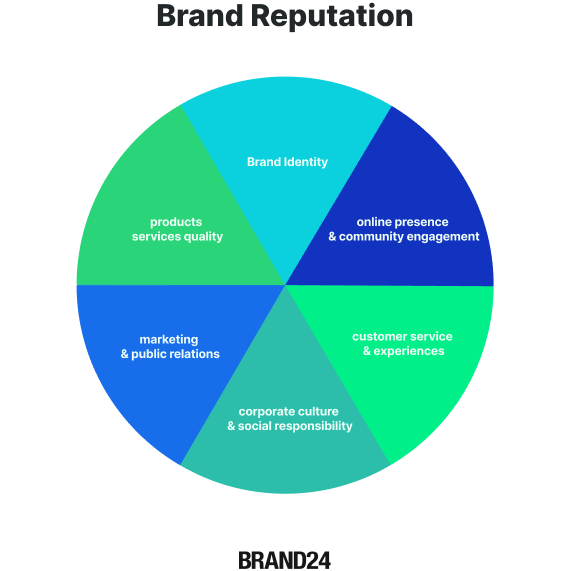
- products or services quality
- brand identity
- online presence and community engagement
- customer service and experiences
- marketing and public relations efforts
- corporate culture & social responsibility
Together, these factors create people’s overall impression of a brand – whether they trust it, admire it, or choose to stay away.
Why is brand reputation important?
Let’s make it clear: brand reputation is a critical factor that impacts (and is impacted by) almost every aspect of a business.
A good reputation means that customers and stakeholders trust the brand and want to support it by buying its products or services, investing in it, and recommending it to others.
And it creates a snowball effect!
Happy customers are more likely to stay with your brand, leave positive reviews, and tell their friends about you.
Those friends become new customers, and if they’re happy too, the cycle repeats again and again.
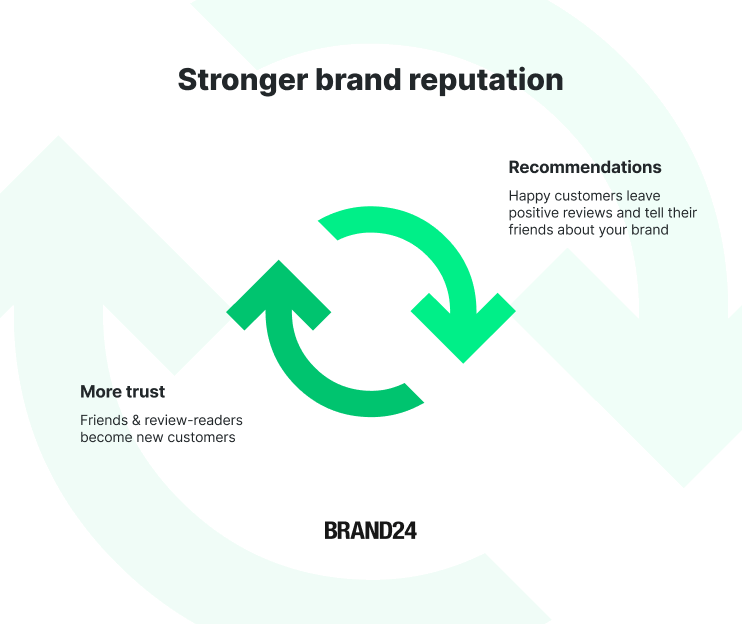
Each satisfied customer is a potential brand advocate who adds new ‘reputation fuel’ to the brand’s credibility and reach engine.
The strong brand reputation:
- Builds customer loyalty and trust, making them more likely to continue buying your products or services.
- Helps survive in difficult times, as trusted brands are more likely to retain support when things go wrong.
- Increases business value, because a strong reputation enables selling products & services at higher prices (that’s why iPhones are expensive!) and strengthens investors’ confidence.
- Attracts top talents since people prefer to work for companies with a good brand reputation.
- Improves your brand visibility and searchability both in traditional search engines & AI-powered chatbots.
On the contrary, a poor reputation can cause people to avoid the company or stop buying its products.
Common reputation risks (with real-life examples)
“It takes many good deeds to build a good reputation and only one bad one to lose it.”
Benjamin Franklin
According to the WTW’s Reputational Risk Readiness Report, reputation is among the top five corporate risks for over half (55%) global senior executives. For 26% of them, reputation gets to the top 3 risks.
So, let’s take a look at the six common reputation risks with a real-life example for each of them:
1. Cyberattacks and data breaches
In 2017, Equifax experienced a huge data breach that leaked the personal data of 147 million people, including Social Security numbers and credit card details.
The company was heavily criticized for delayed information and poor data security practices, leading to a $700 million settlement and long-term damage to its reputation.
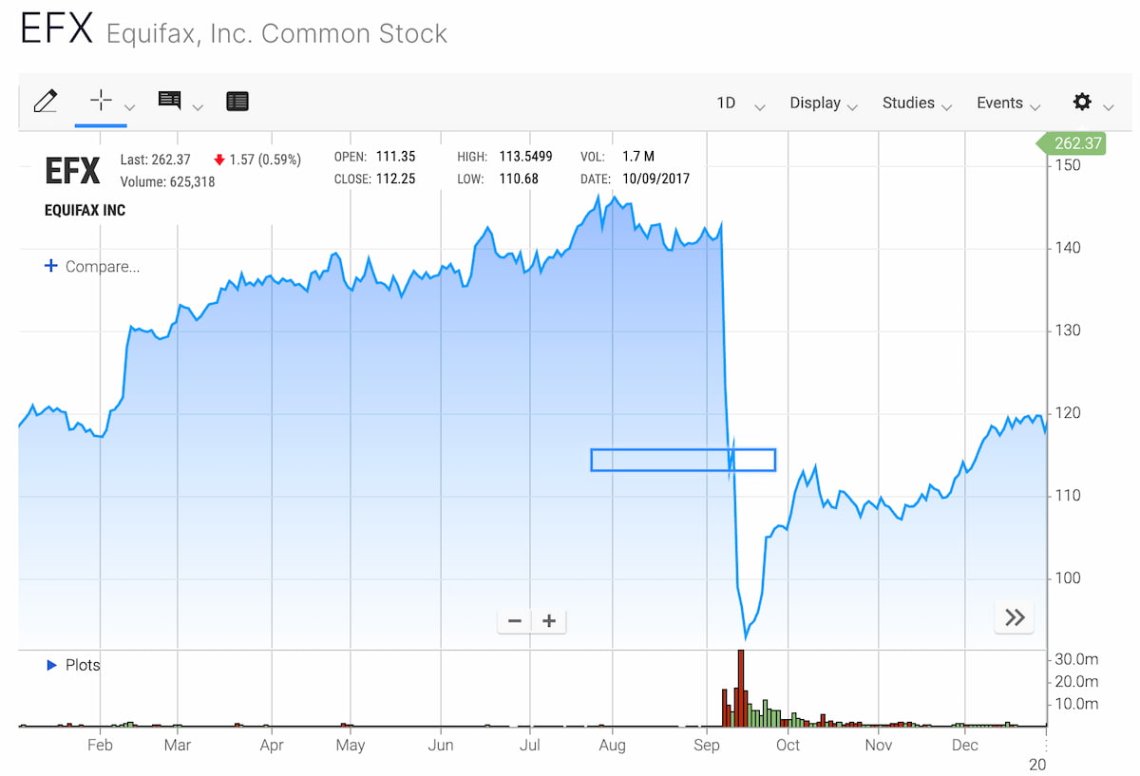
2. Frauds
In 2016, Wells Fargo – one of the largest and most respected banks in the US – was caught in a major scandal after employees secretly opened millions of fake accounts to meet sales targets.
The loss of trust led to angry customers, big fines, and long-term damage to the bank’s reputation and finances.

3. Poor customer service
In 2017, United Airlines faced huge criticism after a video showing a passenger being dragged off an overbooked plane.
The airline’s first response didn’t show much care or responsibility, which made people even more upset.
The video quickly went viral and damaged brand’s reputation.
4. Low quality of products or services
Boeing – once known as a very reliable and respected airplane manufacturer – lost a lot of trust in January 2024 after a serious safety problem.
A part of the plane’s side (a door plug) blew off mid-air on a new Alaska Airlines flight, causing a hole in the cabin wall. Later, it turned out that important bolts were missing.
Boeing had to stop many planes on the ground, and people started to question how safe and careful the company really was.
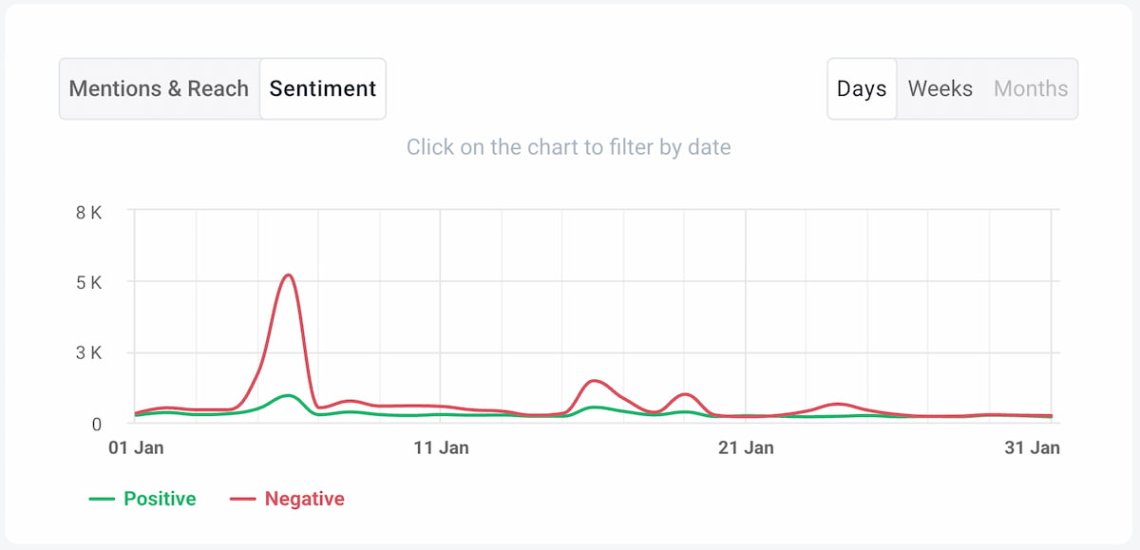
Investigations revealed poor manufacturing practices, such as accepting substandard parts and prioritizing speed over quality, which contributed to ongoing safety concerns.
5. Negative reviews
A Union Street Guest House in Hudson got into serious trouble after the news that it threatened to charge wedding guests a $500 fine for every negative review they posted online.
The hotel’s controversial policy went viral, leading to thousands of 1-star reviews on Yelp and public scrutiny.
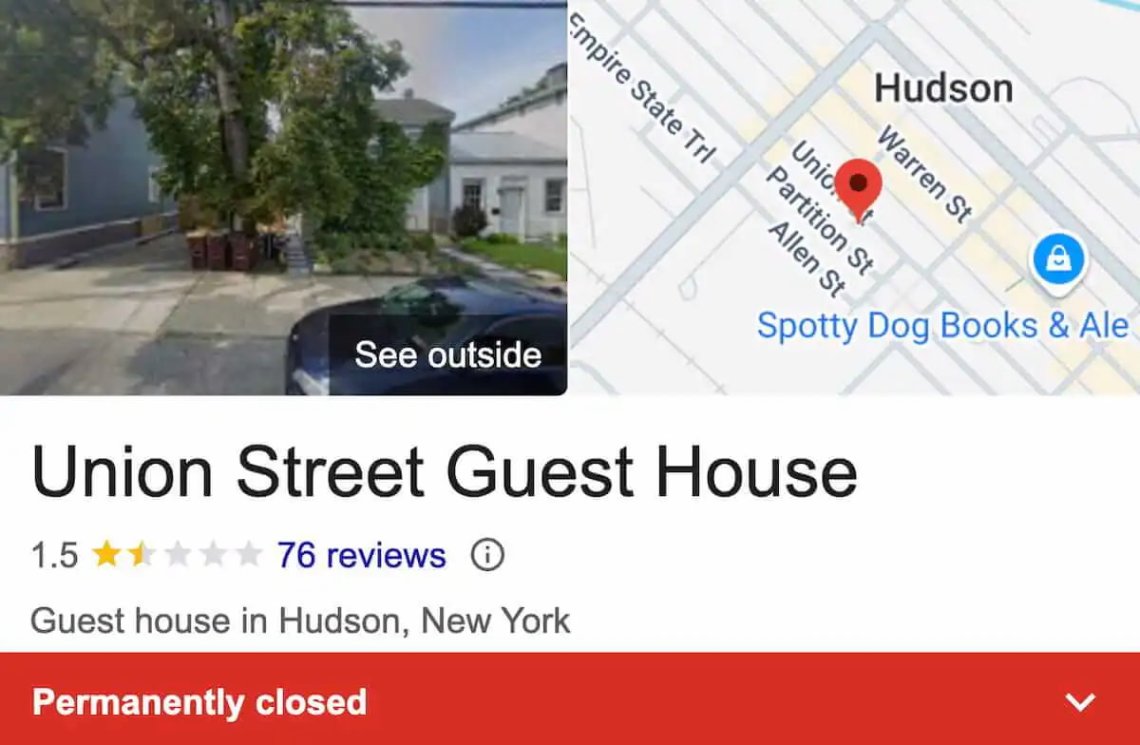
6. Underdelivering
In 2020, Cyberpunk 2077 was one of the most anticipated games in the world. But when it was released, it was full of bugs and didn’t work well, especially on older consoles.
Despite the game developers fixed most of the problems, the huge hype led to big disappointment.
For many players, the game became a symbol of a flop, causing serious reputation and financial losses for the company.
How to build a brand reputation? 8-step strategy
Step 1: Check your current reputation
To start building your brand reputation management strategy, you should know your current reputation.
Having a reference point is important because it allows you to check if your further actions (that we’ll discuss in the next steps) really improve your reputation.
How to do it in practice?
Measuring brand reputation is not the easiest task. Because reputation is not trousers and you can’t simply check the size tag.
Instead, you need to check relevant brand reputation aspects, such as:
Brand sentiment
Sentiment analysis is a process that helps you understand how people feel about your brand when they discuss it online.
Tracking sentiment over time can show you whether your reputation is improving or quite the opposite.
For example, launching a marketing campaign can increase the volume of mentions, but only sentiment analysis will reveal if the buzz actually improved your brand reputation.
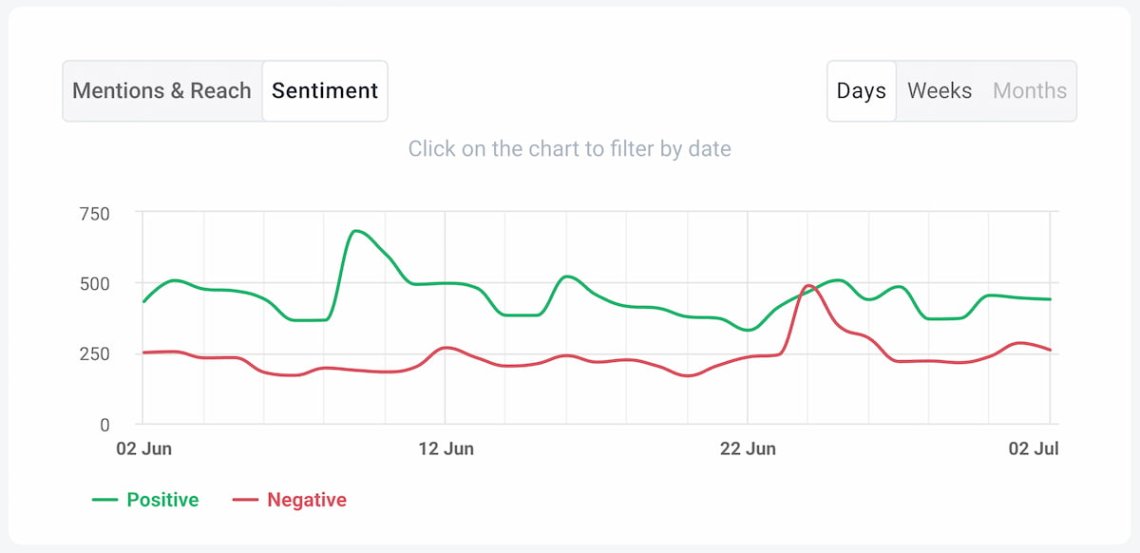
The good news is that you don’t have to do a sentiment analysis manually. There are tools that can do the heavy lifting for you.
One of them is Brand24.
This AI-powered social listening tool tracks and analyzes public mentions published on multiple online sources, such as:
- Social media platforms – Facebook, Instagram, X (Twitter), YouTube, LinkedIn, TikTok, Reddit, Bluesky, Telegram & Twitch
- News sites, blogs, video platforms, podcasts, newsletters, forums & other websites
- Review sites – TripAdvisor, Yelp, Booking, App Store, Google Play & Trustpilot.
Example:
Below, you can see the sentiment chart for Garmin – the world’s leading brand in sports smartwatches.
The advantage of positive mentions is overwhelming and indicates a very positive brand sentiment.
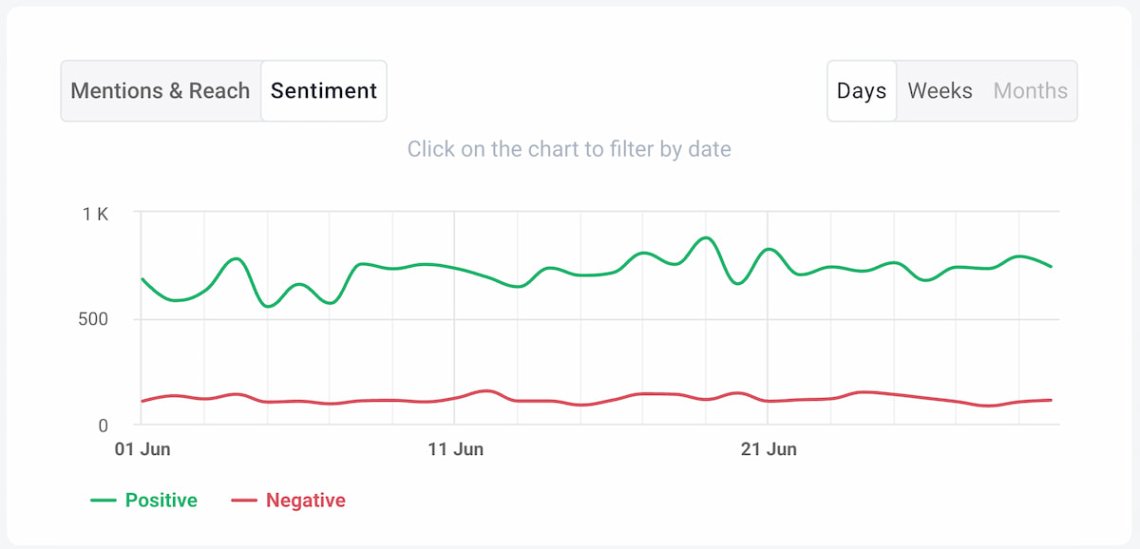
Share of Voice
Share of Voice (SOV) is a metric that shows the percentage of all online conversations that mention your brand, compared to selected competitors or the whole industry.
In other words, SOV shows how big your brand’s slice of the conversation pie is.
The more people talk about you (compared to others), the bigger your Share of Voice.
Example:
Let’s check the SOV for three smartwatch brands: Garmin, Apple Watch, and Suunto.
As you can see, Apple Watch is the most frequently discussed brand among the three of them when it comes to social and non-social media combined.
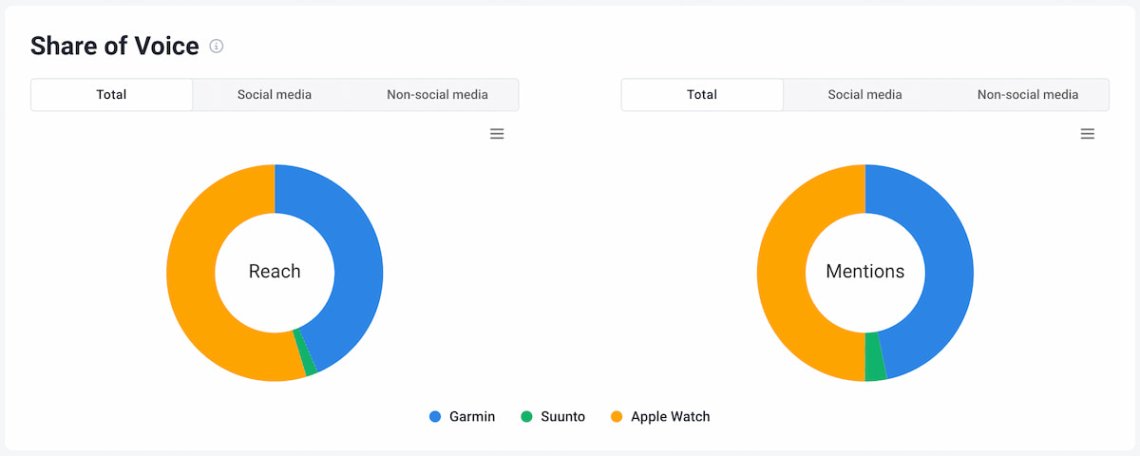
The situation changes when we focus on social media presence only.
It turns out that Garmin has a definitely stronger position there.
Not surprised at all, as the brand strategy centers around encouraging its target audience to share the user-generated content.
A conclusion?
Garmin should invest more in its PR efforts to increase its total Share of Voice (and thus, brand reputation).
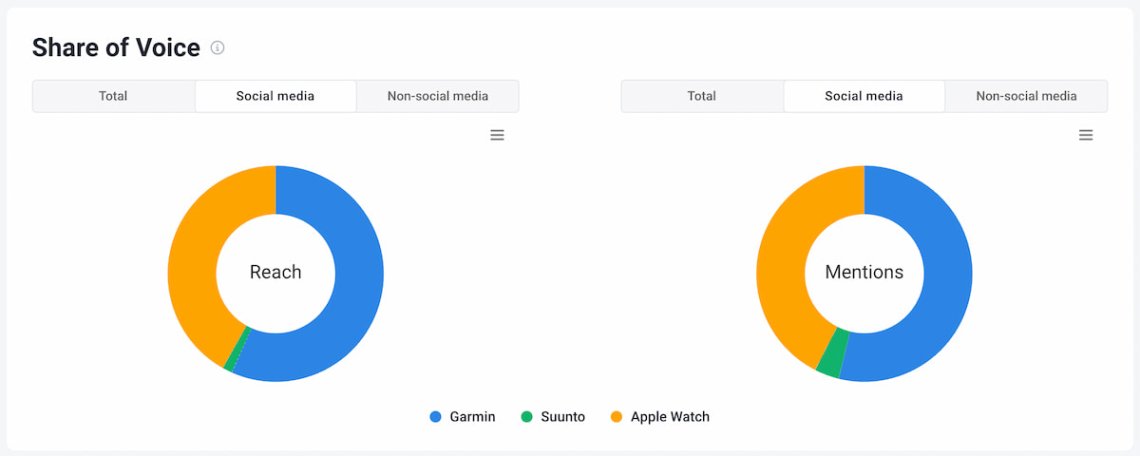
Net Promoter Score (NPS)
Net Promoter Score (NPS) is a simple but powerful metric that tells how likely your customers are to recommend your brand to others.
The score is based on one key question: “On a scale of 0 to 10, how likely are you to recommend our brand?
Depending on the score, people are categorized into three groups:
- Promoters (9–10): Loyal customers who will keep buying and encourage others to do the same.
- Passives (7–8): Satisfied but unenthusiastic customers who are pretty likely to migrate to your competitors.
- Detractors (0–6): Dissatisfied customers who might discourage others from choosing your brand.
Ultimately, the NPS is counted as follows: NPS = % of Promoters – & of Detractors.
This score can range from -100 (everyone is a detractor) to +100 (everyone is a promoter).
The higher your score, the stronger your brand reputation and customer loyalty.
Why is Net Promoter Score a good brand reputation metric?
Because people trust people more than any other type of marketing.
In fact, according to Nielsen’s Global Trust in Advertising report, 92% of consumers trust word-of-mouth above all other forms of advertising.
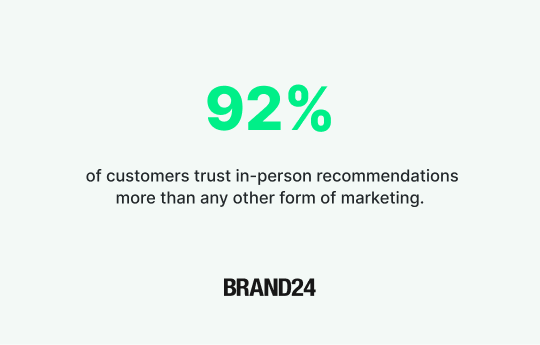
Besides, if your customers recommend you, it means your brand delivers value, is trustworthy, and builds lasting relationships.
For more details about checking your current reputation, read our article: How to measure brand reputation?
Step 2: Build a strong brand identity
Whether you like it or not, people judge the book by its cover.
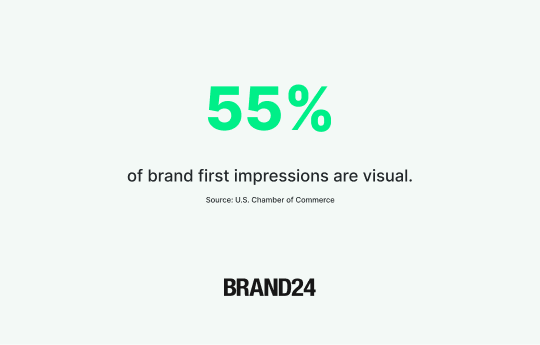
Your logo, color schemes, typography, tone of voice, and personality shape the people’s perception of your brand.
A consistent brand identity positively impacts how others perceive you and sets customers’ expectations from their interactions with your brand.
The more harmonic your brand identity is, the higher the chance your company’s image will be positive in customers’ eyes.
Further read: How to build a strong brand identity?
Step 3: Deliver quality products or services
Okay, it seems obvious, but I still see many brands that do not understand this simple truth: if you want a positive brand reputation, deliver quality products and services!
It’s extremely important, as, according to KPMG’s “The Truth About Customer Loyalty” report, product quality is the most important factor impacting trust and repeat purchases.
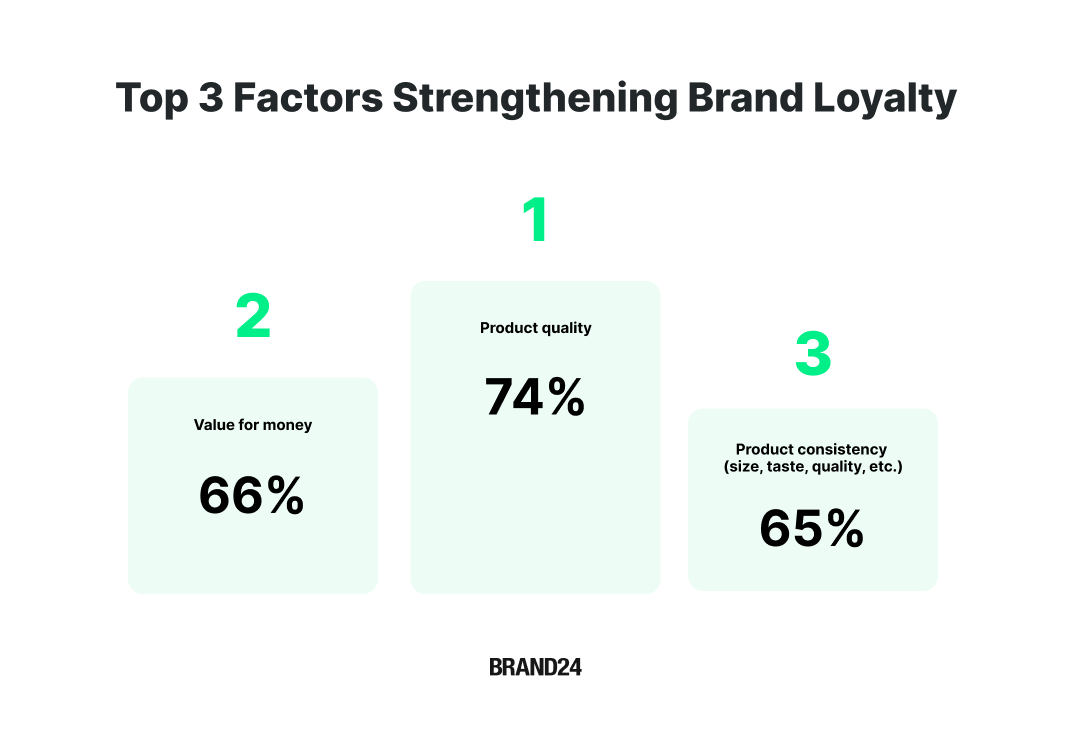
Seriously, in today’s tough competitive market, quality is not a bonus but a basic expectation.
You can have the most creative marketing campaign, an outstanding brand identity, and even the kindest customer care, but if your product or service disappoints, people will walk away.
Even worse! They’ll talk about it.
In fact, customers are 21% more likely to leave a negative review after a bad experience than publishing positive review after a good one.
And that’s a direct route to a poor brand reputation.
Don’t go this way.
Step 4: Set up a strong online presence
If you take your brand reputation strategy seriously, you should also implement a strong online presence.
People trust the things they know, so let them know you!
Social media is where brands can communicate with their target audiences in the most direct and authentic way.
It’s your chance to show personality, share your brand values, tell your story, build relationships, and convince people that your brand is worth their time and trust.
But it’s not just about being present – it’s also about being intentional.
Every social media post, comment, story, and reply is a small brick in your brand reputation house.
Besides, social media presence really impacts business success!
According to the Sprout Social Index, 77% of consumers are more likely to buy from brands they follow on social media.
💡 Pro tip: be active where your audience is
If you have limited resources, focus on the most important social media platforms.
Brand24’s AI Metrics Analysis shows which sources generate the widest reach of your brand message.
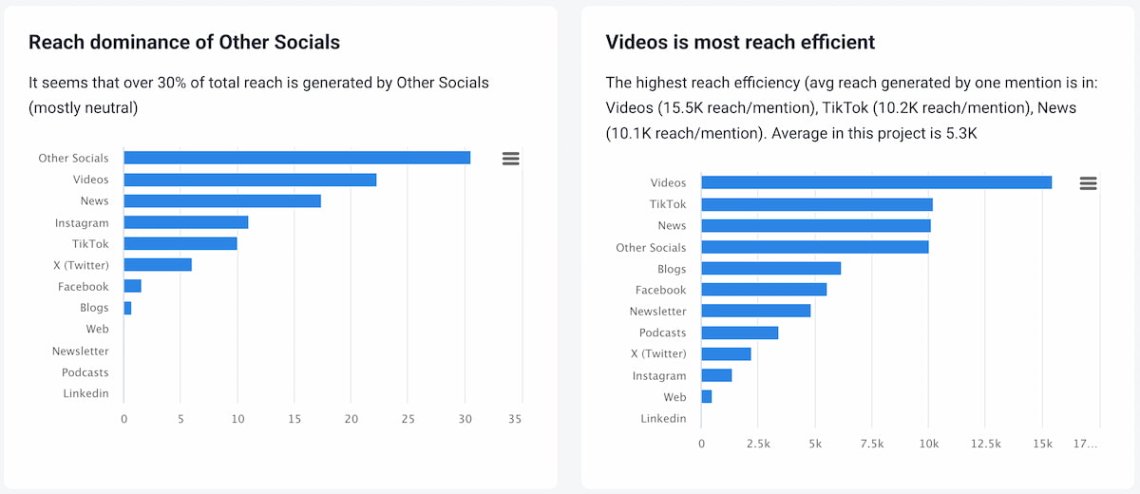
Public relations helps you manage how your brand is seen in the media and by the general public.
It’s about telling your story through press releases, guest articles, interviews, and media coverage.
Also, PR allows you to position yourself as an expert in your field, which builds a positive brand image.
Step 5: Provide excellent customer service
Your customer service isn’t just solving problems – it’s shaping your company’s reputation every day.
Therefore, customer satisfaction should be one of your top priorities.
Every interaction, whether it’s answering a simple product question or resolving a serious issue, is an opportunity to build trust, loyalty, foster brand advocacy, and increase spending.
And there I have data for that claim!
According to Zendesk Benchmark data, nearly 3 out of 4 (73%) customers will abandon a brand for its competitor after a few bad experiences.
Okay, but what should you prioritize to make your customer service support brand reputation?
The three golden rules are:
- Responsiveness
People expect fast answers. The longer they wait, the more frustrated they become. - Empathy
Listen actively and treat people like humans, not ticket numbers. - Problem-solving mindset
Focus on solutions, not excuses. Customers want their issue fixed.

Further read: Most Important Customer Service KPIs
Step 6: Ask for feedback – and reply
Feedback is a gift.
It allows you to understand how your customers perceive your brand, the company’s products, your customer service, and overall brand performance.
Hence, don’t hesitate to ask your customers for honest opinions and treat them seriously!
Use short surveys after purchases, chat interactions, or support tickets. Metrics like NPS and Customer Satisfaction Score (CSAT) work great.
But collecting feedback is only half the job. The other half?
Responding to it.
Why is it so important?
Because 97% of people who read online reviews will also read your responses to reviews (according to Synup).
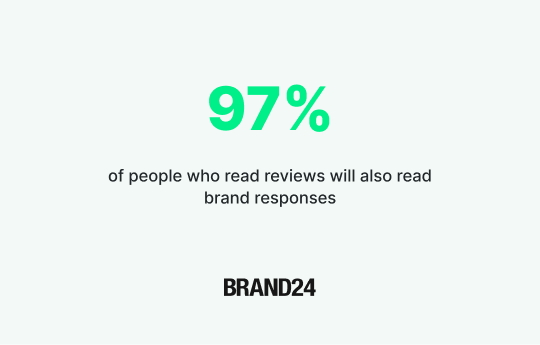
And how you reply shapes their perception. Sometimes more than the review itself.
Therefore:
- Thank people for positive feedback – it shows that you care about your customers and strengthens your loyal customer base.
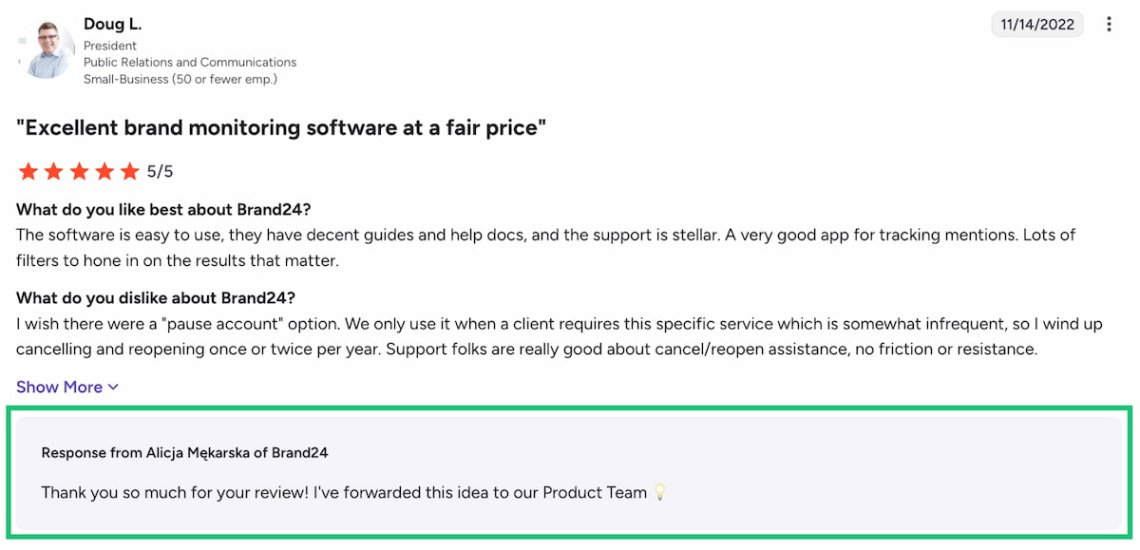
- Address negative feedback quickly and constructively – managing negative reviews is an art of empathy. A thoughtful reply can turn frustration into trust.
Further read: How to Reply to Negative Reviews
- Spot patterns – if several customers complain about the same thing, it’s a red flag. It might indicate the need for product or service updates.
💡 Use AI tools to uncover frequent problems
With Brand24’s AI Brand Assistant, you can quickly discover the most frequently mentioned issues around your brand, products, or services.
As Brand Assistant works similarly to ChatGPT – but is equipped with internal project data – you just need to type a prompt.
Example:
I asked the Brand Assistant to identify the most popular complaints about the GoPro Quik app (it’s a GoPro’s native tool for editing videos).
Within seconds, I received a list of the most frequently reported issues with examples and a direct link to online conversations. Nice!
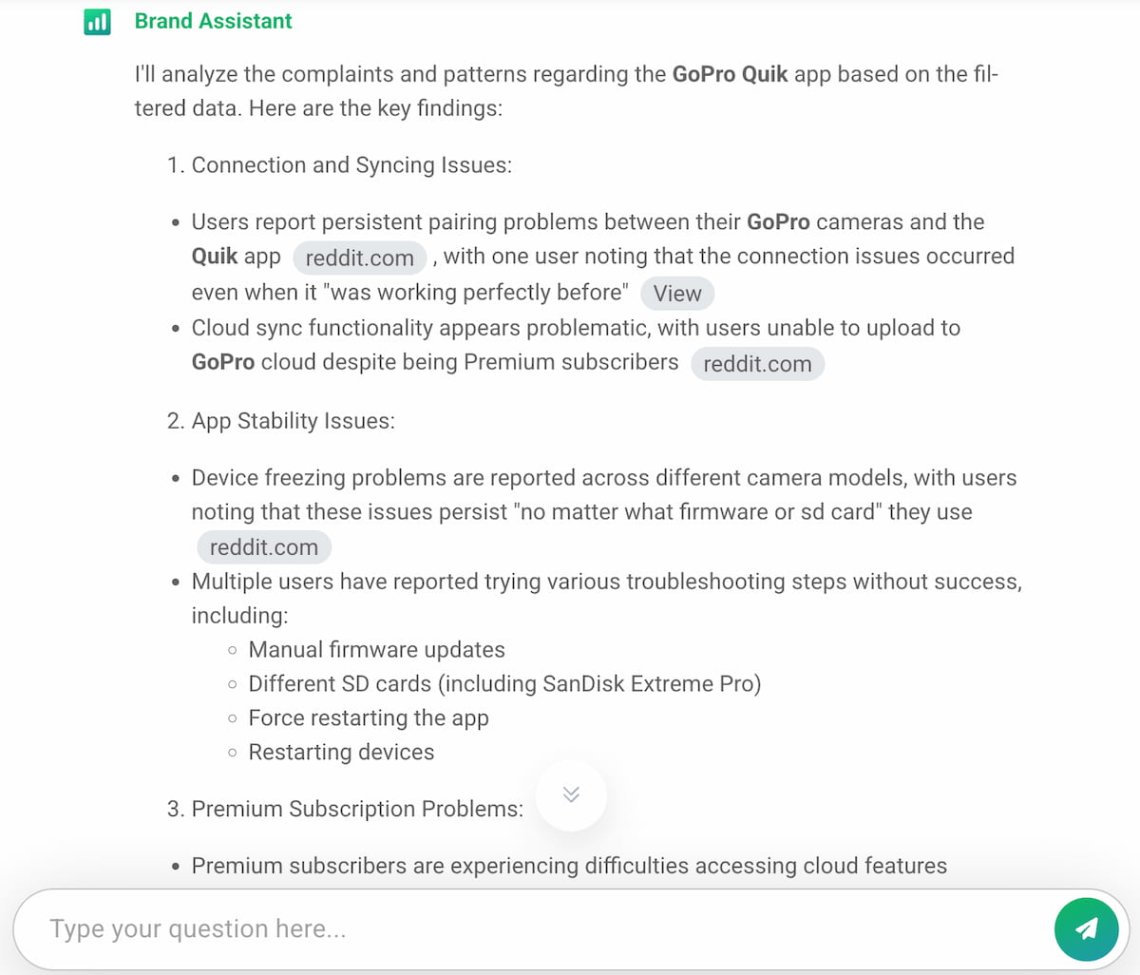
Step 7: Keep monitoring your brand reputation
Brand reputation is not given once and for all. It constantly fluctuates.
Therefore, after examining your brand reputation and implementing good practices to improve it, the third step should be monitoring your brand performance.
The best way to know if your actions strengthen your brand reputation is to have a reference point.
In other words, you should compare your current performance with the past.
Brand24 allows you to do it.
Visit the Comparison tab, select the Compare Periods feature, and set up the dates to benchmark.
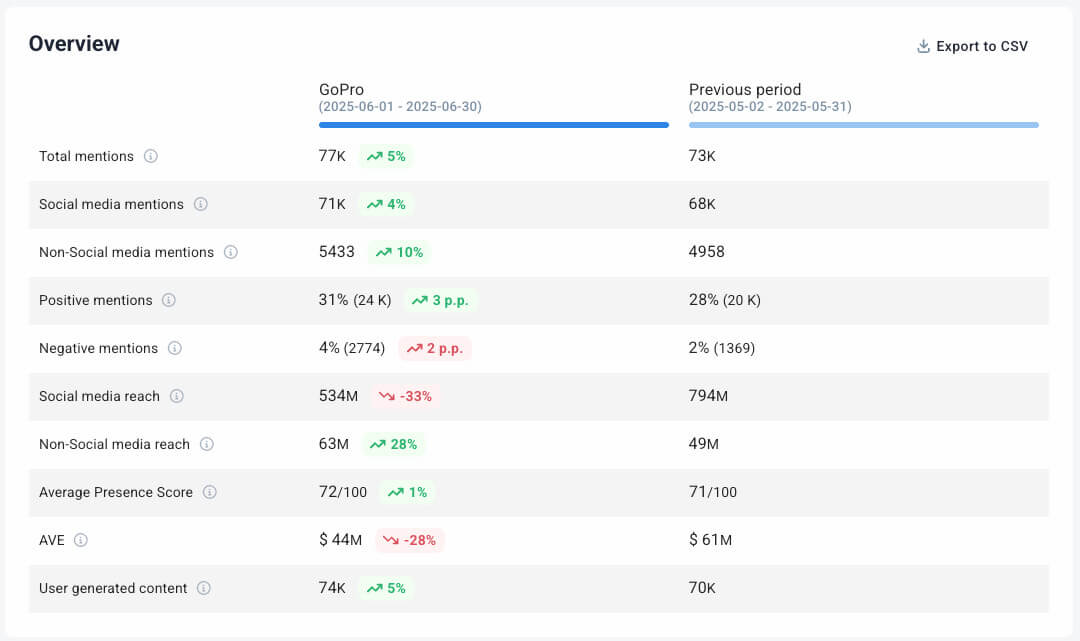
Later, scroll down to see positive and negative sentiment charts.
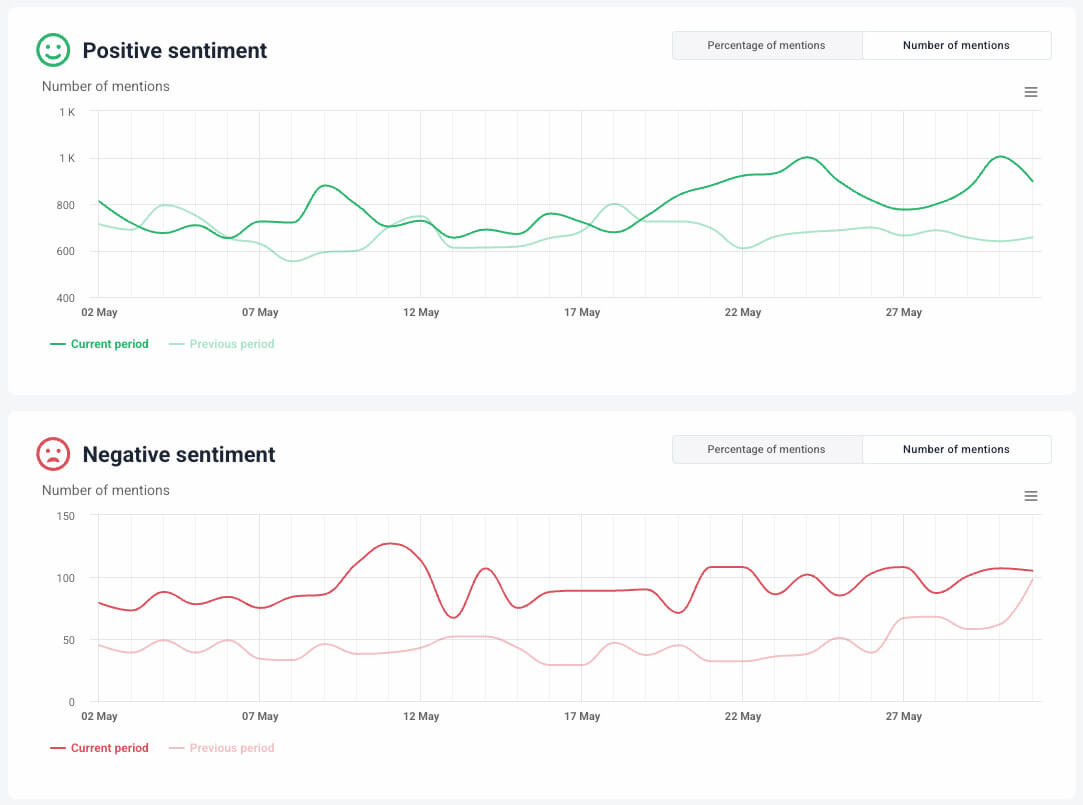
The stronger colors inform you about the sentiment trend in the present period. The lighter ones show what it looked like in the previous period.
Look at the positive sentiment chart.
If the dark line is mainly above the light one, it’s a sign that your efforts to build brand reputation are successful.
On the contrary, if the darker line is mainly above the lighter one on the negative sentiment chart, you should revise your brand reputation management strategy.
Step 8: Prepare for crisis
Thinking about potential crises is uncomfortable. But not thinking about them is irresponsible.
Imagine a tree.
It takes years to grow through consistent effort. But it only takes one storm to break it.
The same story applies to brand reputation.
One unexpected event – a product outage, a social media viral, or a security breach – can damage years of hard work.
That’s why preparing for a crisis isn’t a “nice-to-have.” It’s a must.
Here’s how to get ready before the storm hits:
- Have a crisis plan
Define roles, responsibilities, and communication channels. Everyone on your team should know exactly what to do when things go wrong. - Set up media monitoring tools
Use tools like Brand24’s AI Events Detector to identify sudden spikes in mentions or sentiment shifts. This feature spots unusual activity, helping you discover early signs of problems.
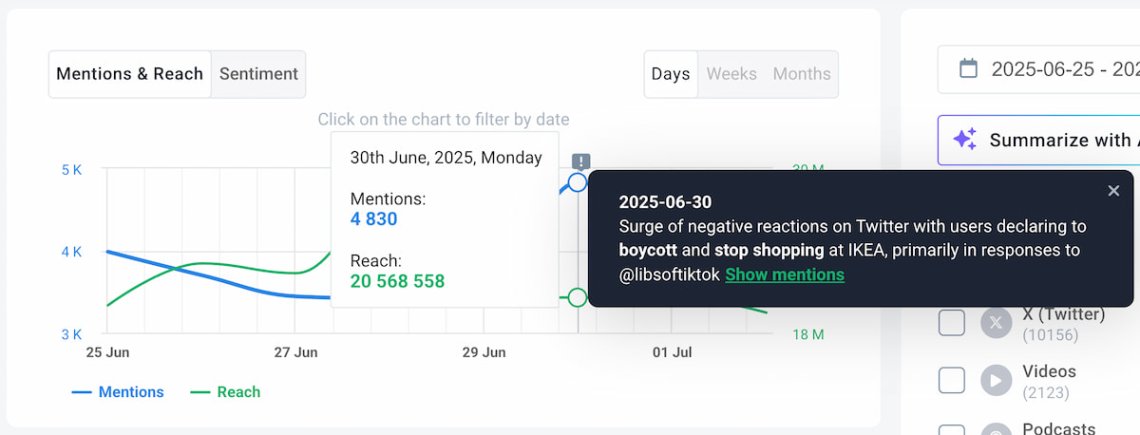
- Turn on Storm Alerts
Brand24’s Storm Alerts notify you instantly when there’s an unexpected spike in online mentions. It gives you valuable time to act before a crisis escalates.
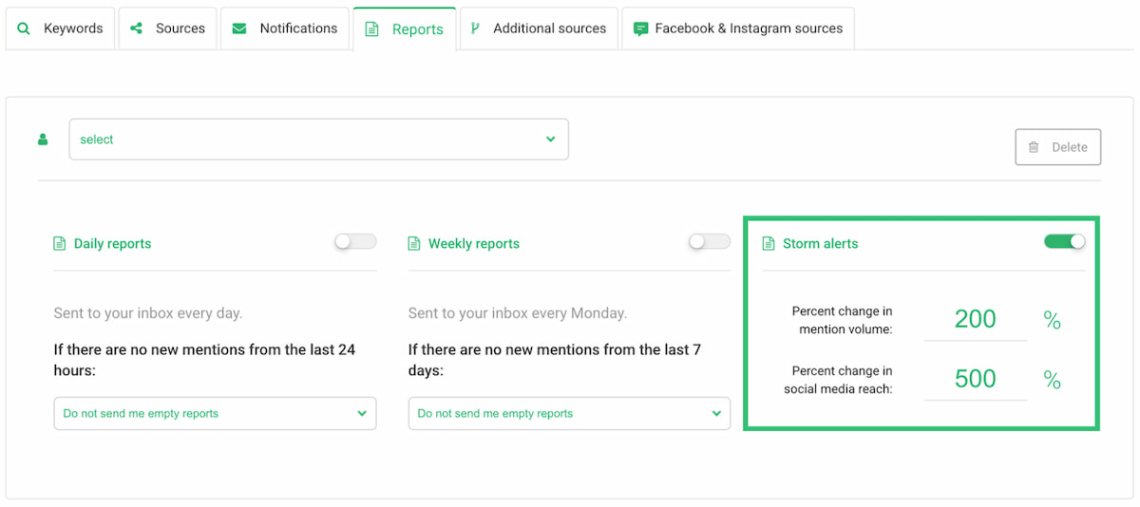
- Prepare response templates
Draft clear, empathetic messages for different scenarios (e.g., service issues, negative press). Customize them quickly when needed. - Act fast, stay human
When a crisis happens, let your audience know you are aware of it, share what you’re doing to fix it, and update people regularly. All with honesty and empathy.
Conclusion
Managing your brand’s reputation is crucial for your long-term business growth.
By understanding how others perceive your brand and actively managing it – from product quality and customer service to social listening and creating a crisis plan – you can build a foundation of trust and loyalty.
Because every interaction matters. And every mention counts.
With the right tools – like sentiment analysis, Share of Voice, NPS, and Brand24’s AI-powered features – you can protect your brand from potential risks, respond faster, and turn satisfied customers into advocates.
Remember: a strong reputation is like a tree. It takes time to grow, but just one storm to fall. So take control, stay consistent, and treat your reputation as the living force it truly is.
Want to learn more about how social media monitoring affects brand reputation?
Check out real-time analytics using the Brand Checker.
Final thoughts:
- Brand reputation shields your brand and helps it survive in difficult times.
- Regularly monitor your brand’s reputation to avoid potential issues and understand if your efforts work.
- Quality is essential for a positive reputation. Deliver quality products and excellent customer service.
- Technology is here to help. Use tools like Brand24 to monitor your reputation, improve it, and spot emerging problems.
- Treat feedback seriously because it delivers valuable insights. Respond to reviews, spot recurring complaints, and upgrade your products & services.
Start a Brand24 free trial and see how it helps build a strong brand reputation!





